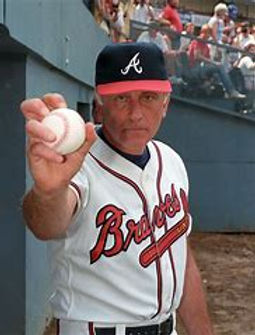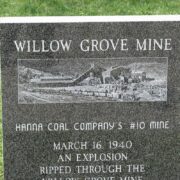
Famous Athletes
Among the notable natives of Belmont County are many athletes. To say sports are popular in the Ohio Valley and that hometown rivalries still exist would be an understatement.
These natives made names for themselves in professional sports teams in the arenas of football, baseball, basketball, and wrestling.
1. Phil Neikro
Nicknamed “Knucksie”, Neikro is a former Major League Baseball (MLB) pitcher. He was inducted into the Baseball Hall of Fame in 1997. Niekro’s 318 career victories are the most by a knuckleball pitcher and he ranks 16th on the overall all-time wins list. He also won the National League Golden Glove Award five times. Niekro pitched for 20 seasons for the Milwaukee and Atlanta Braves. During his tenure in Atlanta, Niekro was selected for five All-Star teams, led the league in victories twice and earned run average once. Niekro was also a key to the only two division titles Atlanta won before 1991. Phil and his brother Joe Neikro amassed 539 wins between them, the most combined wins by brothers in baseball history. Phil Niekro’s 121 career victories after the age of 40 is a major league record, and his longevity is attributed to the knuckleball which is a difficult pitch to master but is easy on the arm and often baffles hitters due to its unpredictable trajectory.

Phil Neikro is a Baseball Hall of Fame inductee.
2. Bobby Douglas
Robert Edward “Bobby” Douglas (born March 27, 1942 in Bridgeport) is a retired American freestyle wrestler and coach. He competed as a featherweight at the 1964 and 1968 Olympics and placed fourth in 1964. He won a silver and a bronze medal at the 1966 and 1970 world championships, respectively, and retired later in 1970. After that Douglas coached several U.S Olympic teams, is one of only four collegiate coaches to win more than 400 dual meets, and he won an NCAA team national title at Arizona State. His coaching accomplishments include: 13 NCAA champions, 110 All-America performances and 68 conference titles.
Douglas added to his legacy by coaching Cael Sanderson to a gold medal in the 185-pound weight class at the 2004 Olympics in Athens, Greece. Douglas was named the 2004 USA Wrestling Freestyle Coach of the Year. In January 2005, Douglas was honored with the Edward Clark Gallagher Award, which is presented annually to the Oklahoma State wrestling alumnus who exemplifies the spirit and leadership eminent in the tradition of champions. He also received the 2005 Iowa State Alumni Association Impact Award. Douglas was inducted into the NAIS Hall of Fame in 1985, the Arizona Wrestling Hall of Fame in 1999, the Dan Brands Hall of Fame in 2002, and the OVAC Hall of Fame in 2004. In his career, he has coached many Olympians who placed in the top three in the world.
Douglas has written several books on wrestling technique: Takedown I, Takedown II, Pinning and Olympic Technique, Take It To The Mat, Wrestling Skills and Drills, and The Last Takedown. He is one of a handful of gold certified U.S. coaches.

Born in Bridgeport, Bobby Douglas had a legendary wrestling and coaching career.
3. John Steven Pramesa
A Barton native, Pramesa (August 28, 1925 – September 9, 1996) was a professional baseball player. He was a catcher in the Major Leagues from 1949-1952 for the Chicago Cubs and Cincinnati Reds. He threw and batted right-handed, stood 6 feet 2 inches tall and weighed 210 pounds.

John Pramesa was a catcher in the Major Leagues from 1949-1952 for the Chicago Cubs and Cincinnati Reds.
4. John Havlicek
NBA Hall of Famer John Havlicek, who won a national championship for The Ohio State University, won eight NBA championships with the Boston Celtics and was named Finals MVP in 1974. He was born in Martins Ferry in 1940. He died April 25, 2019 at the age of 79.

John Havlicek won eight NBA championships with the Boston Celtics and was named Finals MVP in 1974.
5. Sol White
King Solomon “Sol” White (June 12, 1868 – August 26, 1955) was a professional baseball infielder, manager, and executive, and one of the pioneers of the Negro leagues. An active sportswriter for many years, he wrote the first definitive history of black baseball in 1907. He was elected to the Baseball Hall of Fame in 2006.
Born in Bellaire, White made a name for himself first locally, then regionally for his ability to play many positions. He is perhaps best known for writing History of Colored Base Ball, also known (on the title page) as Sol White’s Official Base Ball Guide.

Sol White was a professional baseball infielder, manager, and executive. He was one of the pioneers of the Negro Leagues and wrote the first definitive book about it.
6. Lou “The Toe” Groza
Lou Groza, nicknamed “The Toe”, was a football placekicker and offensive tackle who played his entire career for the Cleveland Browns in the All-American Football Conference (AAFC) and the NFL. Groza grew up in an athletic family in Martins Ferry.

Lou Groza, nicknamed “The Toe”, was a football placekicker and offensive tackle who played his entire career for the Cleveland Browns.
7. Samuel “Sad Sam” Jones
Samuel “Toothpick” Jones (Sad Sam), born in Stewartsville (Belmont County), was a Major League baseball pitcher with the Cleveland Indians, Chicago Cubs, St. Louis Cardinals, San Francisco Giants, Detroit Tigers and the Baltimore Orioles between 1951 and 1964.

MLB pitcher Samuel “Toothpick” Jones (Sad Sam) was born in Stewartsville (Belmont County).
8. Ralph Vince.
Ralph D. Vince (March 18, 1900 – October 29, 1996) was a football player for the Cleveland Indians, Cleveland Bulldogs, and the Cleveland Panthers. He later coached at Baldwin-Wallace College and John Carroll University. Outspoken and inventive as a coach, he was the inventor of the face mask. The original he created is on display at the Pro Football Hall of Fame in Canton, Ohio. He also originated the practice of putting and armband of plays on his quarterbacks’ wrists, now a common sight in the game. He attended Washington and Jefferson College and played in the 1922 Rose Bowl. He is distinguished as being the first Italian to play in the NFL.

A player in both college and professional football, as a coach Ralph Vince invented the face mask.
9. Thomas Clark “Parson” Nicholson
Nicholson (April 14, 1863 – February 28, 1917) was a baseball player whose career spanned from 1887 to 1899. He played principally as a second baseman and in the minor leagues. He did play three seasons in the majors for the Detroit Wolverines in 1888, the Toledo Maumees in 1890, and the Washington Senators in 1895.
Nicholson was born in Blaine, Ohio in 1863 .He received the nickname “Parson” because he refused to play baseball on Sundays.

Thomas Clark “Parson” Nicholson was a baseball player whose career spanned from 1887 to 1899.
10. Frederick Wilson Negus
Frederick Wilson Negus (November 7, 1923 – April 18, 2005) played college football for Wisconsin and Michigan and professional football in the All-American Football Conference and the National Football League.
Negus was born in Colerain and began his college football career with the University of Wisconsin. As Wisconsin’s starting center in 1942, he was selected as a first-team All- Big Ten Conference player by the Associated Press. He was inducted into the U.S. Navy and was assigned to the V-12 Navy College Training Program at the University of Michigan. While at Michigan, Negus played for Fritz Crisler’s 1943 Michigan Wolverines football team; Negus was the starting center on a Michigan team that compiled an 8–1 record, outscored opponents 302 to 73, and won the Big Ten Conference championship (in a tie with Purdue).

Fred Negus played college football for Wisconsin and Michigan and professional football in the All-American Football Conference and the National Football League.
11. Johnny Blatnik
John Louis Blatnik was born on March 10, 1921, to Slovenian immigrants in a small community known then as Goosetown, a close-knit neighborhood just outside of Bridgeport, Ohio.
Blatnik started in the minor leagues before and after serving in the South Pacific during WWII. Blatnik finally made the big leagues in 1948, joining the Phillies as a reserve outfielder. Somewhere along the way, he picked up the nickname “Chief,” though Blatnik said he never knew why.
In 1949 Blatnik was relegated to the bench. After limited action, Blatnik was sent to the Toronto Maple Leafs of the International League, where he batted .294 with 15 homers and 80 runs batted in to warrant a late promotion back to Philadelphia. Overall, Blatnik hit just 1-for-8 in six games with the Phillies, but did appear on his first (and only) baseball card that year with the Bowman company. Unfortunately, his name was incorrectly spelled “B-L-A-T-N-I-C-K” on the card front.
Blatnik saw few opportunities in the Phillies’ magical Whiz Kids year of 1950. Appearing in only four games in the first month of the season, he was hitting .250 on April 27 when he was traded to the St. Louis Cardinals. After hitting just .150 in seven games with St. Louis, on May 14 Blatnik played in his final big-league game before being sent to Houston of the Texas League. There, he turned in a .252 batting average with 9 home runs and 42 RBIs .Blatnik spent the next six seasons in the International League for various teams.
He retired from professional baseball after the 1956 season at the age of 35 and settled in Lansing where he helped start Colt and Pony baseball leagues in the Ohio Valley.

Johnny Blatnik joined the Phillies in 1948 as a reserve outfielder.
12. George “Chappie” Johnson
George “Chappie” Johnson Jr. (May 8, 1877 – August 17, 1949) was an African-American baseball catcher and field manager in the Negro leagues. He played for many of the best teams from 1895 to 1920 and he crossed racial boundaries as a teacher and coach.
Johnson was born and raised in the village of Bellaire. In 1895, he debuted at the age of 17 with the Page Fence Giants,] where he played short stop, left field, then first base, then moved to catcher where he stayed for most of his career. Most of the team moved to Chicago and formed the Chicago Columbia Giants in 1899.
Johnson last played for a major team in 1919 (the eve of the organized Negro Leagues), and continued as a manager through 1939, even managing teams using his name, such as the “Dayton Chappies” and the “Chappie Johnson Stars.” He died at 72 in Clemson, South Carolina.

Chappie Johnson, born and raised in Bellaire was a catcher and field manager in the Negro leagues.




